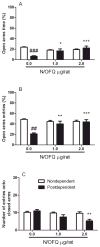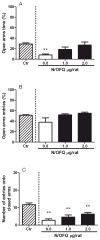Activation of brain NOP receptors attenuates acute and protracted alcohol withdrawal symptoms in the rat
- PMID: 21223310
- PMCID: PMC3066303
- DOI: 10.1111/j.1530-0277.2010.01392.x
Activation of brain NOP receptors attenuates acute and protracted alcohol withdrawal symptoms in the rat
Abstract
Background: Alcohol withdrawal refers to a cluster of symptoms that may occur from suddenly ceasing the use of alcohol after chronic or prolonged ingestion. These symptoms make alcohol abstinence difficult and increase the risk of relapse in recovering alcoholics. In previous studies, we demonstrated that treatment with Nociceptin/orphanin FQ (N/OFQ) significantly reduces alcohol consumption and attenuates alcohol-seeking behavior induced by environmental conditioning factors or by stress in rats. In this study, we evaluated whether activation of brain NOP receptors may also attenuate alcohol withdrawal signs in rats.
Methods: For this purpose, animals were subjected to a 6-day chronic alcohol intoxication (by intragastric administration), and at 8, 10, and 12 hours following cessation of alcohol exposure, they were treated intracerebroventricularly (ICV) with N/OFQ (0.0, 1.0, and 3.0 μg/rat). Somatic withdrawal signs were scored after ICV treatment. In a subsequent experiment, to evaluate N/OFQ effects on alcohol withdrawal-induced anxiety, another group of rats was subjected to ethanol intoxication and after 1 week was tested for anxiety behavior in the elevated plus maze (EPM). In the last experiment, an additional group of rats was tested for anxiety elicited by acute ethanol intoxication (hangover anxiety). For this purpose, animals received an acute dose (3.0 g/kg) of 20% alcohol and 12 hour later were tested in the EPM following ICV N/OFQ (0.0, 1.0, and 2.0 μg/rat).
Results: Results showed that N/OFQ significantly reduced the expression of somatic withdrawal signs and reversed anxiety-like behaviors associated with both chronic and acute alcohol intoxication. N/OFQ did not affect anxiety scores in nondependent animals.
Conclusions: These findings suggest that the N/OFQ-NOP receptor system may represent a promising target for the development of new treatments to ameliorate alcohol withdrawal symptoms.
Copyright © 2011 by the Research Society on Alcoholism.
Figures




Similar articles
-
Modification of anxiety-like behaviors by nociceptin/orphanin FQ (N/OFQ) and time-dependent changes in N/OFQ-NOP gene expression following ethanol withdrawal.Addict Biol. 2013 May;18(3):467-79. doi: 10.1111/j.1369-1600.2012.00466.x. Epub 2012 Jul 15. Addict Biol. 2013. PMID: 22804785 Free PMC article.
-
Low-dose Nociceptin/Orphanin FQ reduces anxiety-like performance in alcohol-withdrawn, but not alcohol-naïve, Male Wistar rats.Neuropharmacology. 2015 Jun;93:1-6. doi: 10.1016/j.neuropharm.2015.01.006. Epub 2015 Jan 21. Neuropharmacology. 2015. PMID: 25617519
-
The nociceptin/orphanin FQ receptor agonist SR-8993 as a candidate therapeutic for alcohol use disorders: validation in rat models.Psychopharmacology (Berl). 2016 Oct;233(19-20):3553-63. doi: 10.1007/s00213-016-4385-8. Epub 2016 Aug 11. Psychopharmacology (Berl). 2016. PMID: 27515665 Free PMC article.
-
The biology of Nociceptin/Orphanin FQ (N/OFQ) related to obesity, stress, anxiety, mood, and drug dependence.Pharmacol Ther. 2014 Mar;141(3):283-99. doi: 10.1016/j.pharmthera.2013.10.011. Epub 2013 Nov 1. Pharmacol Ther. 2014. PMID: 24189487 Free PMC article. Review.
-
The nociceptin/orphanin FQ receptor (NOP) as a target for drug abuse medications.Curr Top Med Chem. 2011;11(9):1151-6. doi: 10.2174/156802611795371341. Curr Top Med Chem. 2011. PMID: 21050175 Free PMC article. Review.
Cited by
-
Restraint stress alters nociceptin/orphanin FQ and CRF systems in the rat central amygdala: significance for anxiety-like behaviors.J Neurosci. 2014 Jan 8;34(2):363-72. doi: 10.1523/JNEUROSCI.2400-13.2014. J Neurosci. 2014. PMID: 24403138 Free PMC article.
-
Korean Red Ginseng attenuates anxiety-like behavior during ethanol withdrawal in rats.J Ginseng Res. 2014 Oct 15;38(4):256-63. doi: 10.1016/j.jgr.2014.05.010. Epub 2014 Jun 7. J Ginseng Res. 2014. PMID: 25379005 Free PMC article.
-
Stress-related neuropeptides and addictive behaviors: beyond the usual suspects.Neuron. 2012 Oct 4;76(1):192-208. doi: 10.1016/j.neuron.2012.09.026. Neuron. 2012. PMID: 23040815 Free PMC article. Review.
-
Nociceptin Opioid Receptor (NOP) as a Therapeutic Target: Progress in Translation from Preclinical Research to Clinical Utility.J Med Chem. 2016 Aug 11;59(15):7011-28. doi: 10.1021/acs.jmedchem.5b01499. Epub 2016 Mar 14. J Med Chem. 2016. PMID: 26878436 Free PMC article. Review.
-
Differential behavioral and molecular alterations upon protracted abstinence from cocaine versus morphine, nicotine, THC and alcohol.Addict Biol. 2017 Sep;22(5):1205-1217. doi: 10.1111/adb.12405. Epub 2016 Apr 28. Addict Biol. 2017. PMID: 27126842 Free PMC article.
References
-
- Bao X, Hui D, Naassila M, Michaelis EK. Chronic ethanol exposure increases gene transcription of subunits of an N-methyl-d-aspartate receptor-like complex in cortical neurons in culture. Neurosci Lett. 2001;315:5–8. - PubMed
-
- Bradford HF. Glutamate, GABA and epilepsy. Progr Neurobiol. 1995;47:477–511. - PubMed

